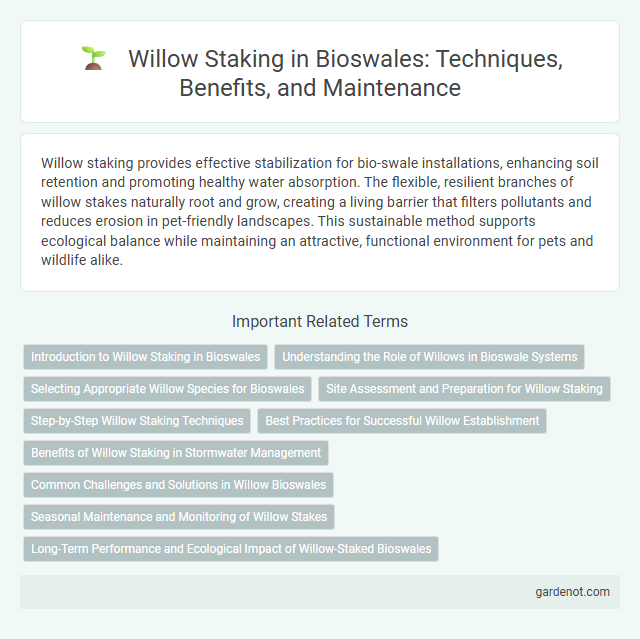Willow staking provides effective stabilization for bio-swale installations, enhancing soil retention and promoting healthy water absorption. The flexible, resilient branches of willow stakes naturally root and grow, creating a living barrier that filters pollutants and reduces erosion in pet-friendly landscapes. This sustainable method supports ecological balance while maintaining an attractive, functional environment for pets and wildlife alike.
Introduction to Willow Staking in Bioswales
Willow staking in bioswales involves planting dormant willow cuttings directly into the soil to enhance erosion control and improve water filtration. These deep-rooted, fast-growing willows stabilize soil, increase infiltration rates, and provide habitat benefits within stormwater management systems. Their natural ability to absorb pollutants and support riparian ecosystems makes willow staking a sustainable method for bioswale vegetation establishment.
Understanding the Role of Willows in Bioswale Systems
Willow staking in bioswale systems enhances soil stabilization and promotes water infiltration through its extensive root network. The fast-growing willow cuttings increase pollutant uptake and contribute to improving stormwater quality by filtering sediments and excess nutrients. Incorporating willow stakes supports ecosystem resilience by providing habitat for beneficial microorganisms and maintaining the structural integrity of bioswales.
Selecting Appropriate Willow Species for Bioswales
Selecting appropriate willow species for bioswales enhances stormwater management by leveraging their high water uptake and robust root systems. Salix alba and Salix nigra are commonly chosen for their adaptability to wet conditions and rapid growth, which stabilizes soil and reduces erosion. Incorporating native willow species ensures ecological compatibility and supports local biodiversity within the bioswale environment.
Site Assessment and Preparation for Willow Staking
Site assessment for willow staking involves evaluating soil moisture, drainage patterns, and sunlight exposure to ensure optimal growth conditions. Proper preparation includes clearing debris, loosening soil to enhance root penetration, and identifying stable planting areas within the bio-swale. These steps maximize willow survival rates and improve water filtration efficiency.
Step-by-Step Willow Staking Techniques
Willow staking in bio-swale construction involves selecting healthy willow cuttings, typically 12 to 18 inches long, and inserting them vertically into prepared holes spaced 6 to 12 inches apart. The cuttings should be buried at least two-thirds of their length to ensure stability and promote root development. Consistent moisture and proper site preparation enhance rooting success, supporting effective erosion control and water filtration in bio-swale systems.
Best Practices for Successful Willow Establishment
Willow staking in bio-swales requires selecting healthy, dormant cuttings 12-24 inches long with a minimum diameter of 0.5 inches to ensure successful root development. Insert stakes at a 45-degree angle, burying two-thirds of their length into moist, well-drained soil to maximize water absorption and stability. Maintaining consistent soil moisture during the initial establishment period promotes vigorous root growth and long-term plant survival in bio-swale environments.
Benefits of Willow Staking in Stormwater Management
Willow staking enhances stormwater management by stabilizing soil and reducing erosion in bio-swales, promoting infiltration and filtering pollutants from runoff. The fast-rooting ability of willow cuttings improves bank reinforcement and increases water retention capacity, mitigating flooding risks. This natural, cost-effective method supports sustainable urban drainage systems and preserves water quality.
Common Challenges and Solutions in Willow Bioswales
Willow staking in bioswales often faces challenges such as poor root establishment due to waterlogging and soil compaction. Selecting appropriate willow species with high tolerance for saturated soils and ensuring proper soil preparation can significantly enhance root penetration and growth. Regular monitoring and adaptive management, including supplemental watering during dry spells and replacing failed stakes promptly, improve survival rates and overall bioswale performance.
Seasonal Maintenance and Monitoring of Willow Stakes
Seasonal maintenance of willow stakes in bio-swales involves regular inspection to ensure stakes remain firmly rooted and healthy, particularly during spring and fall growth cycles. Monitoring includes checking for signs of stress, disease, or pest damage, and replacing any dead or damaged stakes promptly to maintain soil stability and water filtration efficiency. Consistent cutting back of overgrown willows during dormant seasons promotes vigorous regrowth and enhances the bio-swale's ecological functionality.
Long-Term Performance and Ecological Impact of Willow-Staked Bioswales
Willow staking in bioswales enhances long-term performance by promoting robust root systems that stabilize soil and improve water infiltration rates, reducing erosion and surface runoff. The deep root networks of willows also facilitate nutrient uptake and biofiltration, contributing to improved water quality and supporting local biodiversity. Ecologically, willow-staked bioswales create habitats for various wildlife species and increase carbon sequestration, making them a sustainable option for urban stormwater management.
Willow staking Infographic

 gardenot.com
gardenot.com